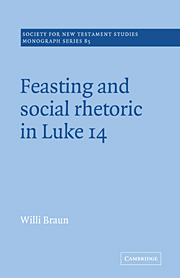Book contents
- Frontmatter
- Contents
- Acknowledgements and note on abbreviations
- 1 Introduction: how to read Luke 14?
- 2 Assumptions and preliminary reading
- 3 Jesus as a healer of craving desire (14.1–6)
- 4 Uncommon ‘symposium rules’ (14.7–11, 12–14)
- 5 The big dinner (14.15–24): aspects of Lukan performance
- 6 The conversion of a wealthy householder
- 7 Forms, genres and composition
- 8 Composition as argumentation: the rhetoric of Luke 14
- 9 Towards closure (and openings)
- Bibliography
- Indices
9 - Towards closure (and openings)
Published online by Cambridge University Press: 28 August 2009
- Frontmatter
- Contents
- Acknowledgements and note on abbreviations
- 1 Introduction: how to read Luke 14?
- 2 Assumptions and preliminary reading
- 3 Jesus as a healer of craving desire (14.1–6)
- 4 Uncommon ‘symposium rules’ (14.7–11, 12–14)
- 5 The big dinner (14.15–24): aspects of Lukan performance
- 6 The conversion of a wealthy householder
- 7 Forms, genres and composition
- 8 Composition as argumentation: the rhetoric of Luke 14
- 9 Towards closure (and openings)
- Bibliography
- Indices
Summary
These last few pages finally are an opportunity to step out of the confines of Luke 14. I leave it behind with a few backward glances at Luke's rhetorical achievement, then briefly ponder what this permits us to say about what L. Bitzer (1968) calls the ‘rhetorical situation’, the real-life situation addressed in Luke's appeal. Finally, as a way of contriving closure and new openings at the same time, I offer several items from a ‘wish list’ of topics in Lukan studies which are suggested by this study and, I think, worthy of energetic scholarly attention.
The rhetorical achievement
The dinner episode has shown itself to be the result of a rather sophisticated compositional planning. Its thematic and rhetorical coherence has become evident and, considering all the elements that had to cohere and recalling that the material in the episode was not entirely cut out of whole cloth, this coherence was achieved against demanding odds. Evidently Luke had learnt something about the usefulness of chreiai for constructing prose arguments and the dinner episode shows that he could apply his learning with refined skill.
He chose (composed) a chreia featuring dropsy as a familiar and highly potent cipher for a range of greedy, gluttonous and hence predatory social behaviours and arrangements that he wanted to excoriate. A cured dropsy would naturally suggest the opposites he wanted to vindicate. The topic of contrast and polarity thus is in place and needs only to be developed and played upon.
- Type
- Chapter
- Information
- Feasting and Social Rhetoric in Luke 14 , pp. 176 - 181Publisher: Cambridge University PressPrint publication year: 1995

